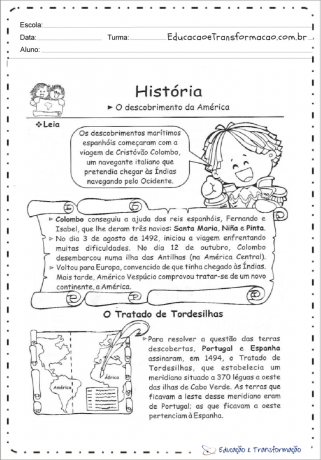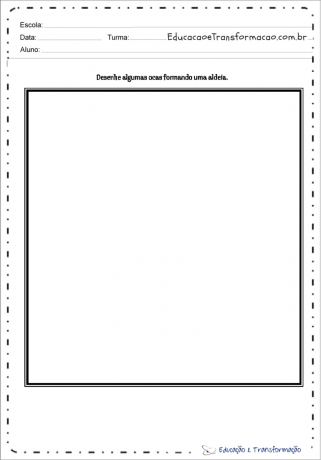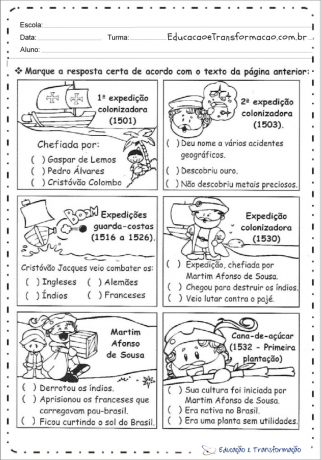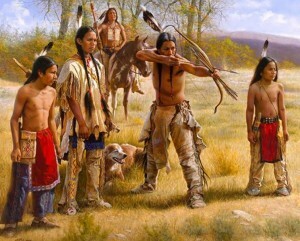We selected in this post some Activities on The First Inhabitants (Discovery of Brazil), ready to print and apply to early graders (Elementary School).
See too:
Index
Discover important words and complete:

See too: Geography and History Play Activities

Draw some hollows forming a village.

List the second column according to the first:

Activities on The First Inhabitants

Activities on The First Inhabitants

Activities on The First Inhabitants

1) In the 2000s, several events were held to celebrate how long the Discovery of Brazil was?
2) Who commanded the arrival of the Portuguese in Brazil in 1500?
3) Mark with an (x) the option that shows the celebrations held to commemorate the 500th anniversary of the Discovery of Brazil:
a) ( ) Bike race, beauty contest, bag race, kite show.
b) ( ) Naval parade, greeting from the president of Portugal, show in São Paulo, photography exhibition.
4) Did the Indians celebrate the arrival of the Portuguese in Brazil? Because?
5) For the Indians, who are the real owners of the land? Because?
6) According to studies carried out at the end of the 15th century, how many indigenous people lived in Brazil?
7) Name five Brazilian indigenous peoples.
8) Are all indigenous peoples equal? Because?
10) The indigenous way of life has several points in common, mark (v) for true and (F) for false in the following statements:
a)(V ) In indigenous societies there was no accumulation of goods, only what was necessary for consumption was produced.
b)(F ) Indigenous people obtained their food in city markets.
c)(V ) The Indians planted corn, cassava and beans.
d)(V ) Everyone in the village is responsible for the education of the children.
e)(V ) The elders were highly respected by everyone and were responsible for telling the stories about their ancestors.
f)(F ) The division of labor was done like this: men took care of the harvest and women took care of hunting and fishing.
g)( V) The indigenous people are very religious and believe in the power of nature.
h)(V ) The shaman is very important to the Indians, as he performs the cures.

Activities on The First Inhabitants
1- What were the first peoples that gave rise to the formation of the Brazilian people?
2- To which of the peoples who helped to form Brazil does the following text refer? They had a developed monetary and banking system. They developed maritime navigation techniques. They produced cloth, gold items and firearms.
3- Regarding the Amerindians who lived in Brazil at the time of the discovery, we can say that:
a) they already practiced commerce.
b) they were not concerned about transmitting their traditions to the younger ones.
c) warred with other tribes to increase their territory.
d) their land and housing were collective.
4- What did African and Amerindian peoples have in common before contact with Europeans? Check the option that corresponds to a characteristic common to both peoples at that time.
a) Be nomadic, moving periodically in search of food and water.
b) Use writing to convey their culture.
c) Enslave and trade slaves.
d) Believing that beings and phenomena of nature were gods.
5- Check the true statement about the Portuguese at the time of the Great Navigations.
a) Only the Portuguese were able to carry out sea voyages.
b) Commerce was an activity of great importance to them.
c) They had not yet mastered reading and writing.
d) Their gods were beings and phenomena of nature.
6- What can we say about the first encounter between the Indians and the Portuguese?
a) Only the Indians were surprised by the Portuguese when they first met.
b) There are written records left by the Indians that show their first impressions of the Portuguese.
c) Even though they speak different languages, there was an attempt to communicate between them.
d) When they first sighted, the Indians and the Portuguese began to attack each other.
7- Regarding the extraction of pau-brasil by the Portuguese in Brazil, we can say that
a) the Indians were against this activity and tried to stop the Portuguese.
b) the Indians agreed to carry out this task in exchange for Portuguese objects and utensils.
c) the Indians were enslaved to carry out this task for the Portuguese.
d) the Indians took a long time to realize what the Portuguese were doing as they took refuge in the interior of the country.
Activities on The First Inhabitants
The first inhabitants of Brazil were the Indians, they were divided into many peoples, distributed over countless villages.
When Pedro Álvares Cabral discovered Brazil in 1500, he only found forests, a wild people without any civilization.
The Indians lived in groups forming tribes, walked almost naked, adorned themselves with colored feathers, necklaces with animal teeth or seeds.
About 5 million Indians lived in what is now Brazil. Indigenous groups speak different languages, have their own culture, customs, skills and social organization. Contact with the white man changed their habits, but the respect for nature and older people remained.
Portugal and Spain developed navigation techniques, which were important centers for maritime exploration, and for the expansion of European culture. They went after the spices of the Orient such as: cloves, cinnamon, pepper, nutmeg, ginger, etc… Following the path to the Indies, that's how the Europeans called the Orient the Indies.
Spices were used for their medicinal properties and to preserve food, because at that time there were no refrigerators.
Trying to reach the Orient, and exploring new paths, the Portuguese sailed through the Atlantic Ocean that reached Brazil.
Pedro Álvares Cabral commanded the expedition that came to Brazil on April 22, 1500, on behalf of the king of Portugal. Upon arriving in Brazil, they encountered many Indians. He took possession of the land and began to exploit the riches.
The Portuguese began exploration, and the first product removed for sale was the tree of Brazilwood, a very valuable wood in Europe, used to make a red dye to dye fabrics.
In exchange for gifts such as: hats, knives, axes, fabrics and mirrors, the Portuguese managed to the indigenous people did all the work, cutting and transporting the heavy trunks of Brazilwood. The exploration of pau-brasil lasted about 30 years.
A colonizing expedition was sent to Brazil under the command of Martim Afonso de Souza in 1532, he founded the first village called São Vicente. He also started the production of sugar cane. At that time, production was very small, so its price was high to produce sugar, so the Portuguese installed several mills.
1- Read the text very carefully and answer the questions.
a) Who discovered Brazil?
b) On what day, month and year did Pedro Álvares Cabral discover Brazil?
c) When Pedro Álvares Cabral discovered Brazil, what did he find here?
d) Which ocean did the Europeans sail until they arrived in Brazil?
e) What was the first product explored by the Portuguese when they arrived in Brazil?
f) What gifts did the Portuguese give to the indigenous people?
g) How many years did the exploration of pau-brasil last?
h) How did the Indians live when the Portuguese arrived here?
i) Who commanded the colonizing expedition sent to Brazil?
j) What is the name of the first village founded by Martim Afonso de Souza?
Subscribe to our email list and receive interesting information and updates in your email inbox
Thanks for signing up.

